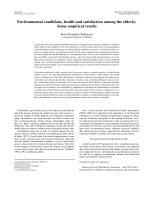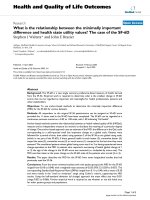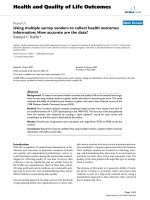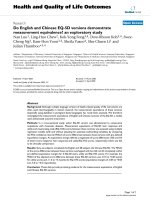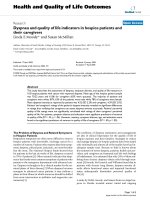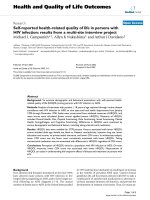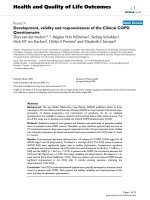research on working conditions, health and diseases of the crew on oceangoing ships of 02 vietnamese ocean shipping companies in 2011-2012
Bạn đang xem bản rút gọn của tài liệu. Xem và tải ngay bản đầy đủ của tài liệu tại đây (379.22 KB, 17 trang )
1
INTRODUCTION
Vietnam is a coastal country with over 3260km coast and 3 time-bigger ocean area compared
with the land. Recently, Vietnam economy has been developing stronger and stronger. Our marine
and coastal economy was defined to become the leading sector with its contributions getting bigger
and bigger. Thanks to its rich potentials, the maritime and coastal economy has been attracting more
and more labors of which has maritime transport sector.
All disadvantages of ocean environment and working conditions on the ships have seriously
affected health and typical disease rising and finally make the impact on working ability and reduce
working age of seafarers.
Cargo fleets of Vietnam Ocean Shipping Joint Stock Company and Vietnam Sea Transport
and Chartering Joint Stock Company. The time of continuous voyages are normally from 11
months to 14 months. Health care works to crews has had difficultlities due to unavailable medical
officers on board or the lack of medicines, medical equipment and even sometimes the impossible
support from coastal clinics.
Thus, what are the aboard working conditions of these companies and how do they influence to
health and typical diseases rising? What are advantagese and disadvantageses of the medical care to
crews? Those considerations pushed us to conduct the study for the following targets:
1. To describe the oceangoing ships working conditions of the two Vietnam Ocean Frieght
companies in 2011-2012
2. To evaluate the situation of crews’ health, disease structure and health change before and after
the voyage.
3. To propose and adopt some health care solutions to Ocean fleets crews of Vietnam.
New contributions of the dissertation
The dissertation identified disadvantages of aboard working conditions and specified health,
disease patterns, long voyage impacts on health, disorders, and diseases of crews. Specially, it pointed
out the medical care reality to crews, proposed the solutions and applied successfully one key solution
of maritime medical care training for deck officers who are responsible for health care on board.
The dissertation layout
The thesis includes 130 pages (Introduction: 2 pages; Chapter 1: Overview 33 pages; Chapter
2: Research subject and method:16 pages; Chapter 3: Research results: 41 pages; Chapter 4:
Discussion: 34 pages; Conclusion and recommendation: 3 pages). There are total 50 tables and 12
figures. References: 154 (75 Vietnamese ones and 64 English ones). The appendix includes Study
template and list of deck officers participating in intervention maritime medicine training.
Chapter 1
OVERVIEW
1.1. NATURAL ENVIRONMENT AT SEA
Natural environment, especially ocean one is regarded as the first factor affecting seafarers’
2
health. They daily face to the tough situations of ocean, including:
+ Impacts of rainstorm, storm and sea waves
The coastal climate in our country belongs to tropical monsoon with many complicated types
that affect our maritime and coastal economic activities as well as harm crews’ health and working
abilities on board, even threat their life. [41]
Waves make direct impacts on aboard activities, for example, high waves can make seasikness
then affect physiological funtions and their working abilities.
+Effects of temperature and solar radiation
When working on board, people are affected directly by hot weather in summer and coldness
in winter. Moreover, the temperature between inside and outside of ship are extremely differen that
makes difficulty in adjusting temperature for body and finally easy to get a cold [129].
1.2. Working conditions in oceangoing ships
1.2.1. Aboard working environment
The crews have to simultaneously suffer from a number of factors’ impacts not only during
working time but relaxing or even sleeping time as well. These factors are microclimate on board;
physical factors such as noise, vibration, lighting, electro-magnetic wave, and ultrahigh-frequency
waves; chemical ones; biological ones and the sudden change when passing different climate areas.
1.2.2 Social conditions, hygiene and nutrition on board
- Aboard microsocial condition: During the voyage, crews are separated from normal life on land,
all their activities are limitted in the narrow ship.
- Nutrition condition on aboard: unbalanced food diets used in the ships cause metabolism
disorders of glucose, lipid, and protein which increases the risks of cardiovascular and aterial
blood pressure problems.
1.3. Health and disease structure of oceangoing freighter crews
1.3.1. Crews’ health description
Labor’s health is key factor to the work completion level and performance. Under a research
conducted to 3.300 workers working for Ocean shipping Companies of Polish Republic, Filikowski J.
[88] found that only 32.8% of workers checked were healthy; 19.21% were in dysfunctions but not
yet in pathological signs; while 42.9% of them were suffering from some chronic diseases. This was
a very high figure. The result was the same as that of Nguyen Van Hoan, Vu Tuyet Minh [25] pointed
out when checking 380 crews working in some Vietnam cargo ships.
1.3.2. Study on diseases of ocean shipping crews
The most popular diseases in crews were circulation, digestion, infection and parasitic, and
mentally behavior disorder diseases.
1.4. Health care and management to ocean shipping crews
1.4.1. The importance of health care works to ocean shipping crews
The international organizations such as ILO, WHO, IMO, and IMHA has enforced many
international conventions on crew health protection, care and improvement and simutaneously set up
3
the health standard frame for crews in order that the member nations can build the health standard
regulations for crews which helps to choose seafarers healthy enough to fit this typical works [99],
[101], [132], [133].
1.4.2. The situation of health care and management to oeangoing freighter crews
- The health care to crews of Ocean freight companies still had shortcomings. Fleets had been
equiped medicine and medical equipment however they were not enough and accordant with
Standard of International Maritime Convention [12], [55], [86]. Many oceangoing shipping
companies had not sent their deck officers to take part in maritime medicine training courses for deck
officers.
- Training and maritime medicine knowledge updating for crews: VOSCOJSC., have paid attention to
health care training for deck officers who would undertake as doctor on board for 15 years.
Chapter 2
RESEARCH SUBJECTS AND METHODOLOGY
2.1. Research subjects, location and time
2.1.1. Research subjects
2.1.1.1. Working condition on the ships
13 cargo fleets of VOSCO and Vitranschart
2.1.1.2. Crews
- Group 1: included 600 crews belonged to VOSCO and Vitranschart, among those there were 193
officers and 407 crews at the age of 36.45± 8,34 years and working experience year of 11,56 ± 5,25
years and they were divided into three groups: deck, engine and servers. All were male.
- Group 2: included 300 crews working on 13 fleets of VOSCO and Vitranschart in of them consist of
103 officers and 197 seafarers
- Intervene group: choose total 104 deck officers among 600 crews of group 1
- Reference group: included 300 labours in land, all males and same age with the studied groups who
were now working in office, interprises located in Hai Phong and had regular health check in
Vietnam National Institute of Maritime Medicine in 2012. This group was checked and mesured all
items same as the studied group 1 and used to be reference group.
2.1.2. Research location: Department of heath management and Examination of seafarers, Maritime
medical training center, Vietnam National Institute of Maritime Medicine, 13 cargo fleets of VOSCO
and Vitranschart
2.1.5. Research period:. From January 2011 to December 2012.
2.2. Methodology
2.2.1. Research design and sampling
2.2.1.1.Research design
- The cross-sectional descriptive study and analyzed to evaluate the working condition and
crews’ health and disease situation of the 2 companies.
- The study described vertically and compared before and after to evaluate the health and
4
disease change of crews before and after the voyage.
- Intervene study: proposed and applied health care and protect solutions to crews working on
the ships.
2.2.1.2. Sampling method and sample size
Sample size of aboard working conditions
The fleets of VOSCO included 19 cargo ships, of which 11 large vessels were working in
ocean world wide. We chose 8 fleets randomly among those 11.
The ocean fleets of Vitranschart included 13 cargo ships, of which 9 large vessels were
working in ocean world wide. We aslo chose randomly 5 ones.
The 13 ships above of the Two companies would be surveyed the working conditions.
Method of taking and surveying working condition models
- We surveyed microclimate, noise, vibration on the cargo ships in different places such as
cabin, deck, engine rooms and crew rooms; 5 models per each place as under the regulation of taking
sample in working condition surveying.
Sample size of crews’ health status and disease structure
At the time of studying, there were total 1,200 crews of both companies, thus, to increse the
reliability of research figures, we chose 600 crews (50%) to have regular health check and entry
health check before working on board at Health Management and Examination Department of
seafarers from January 2011 to December 2012.
Sample size of crews’ health and disease change before and after a voyage.
- We took all members joining the voyage of 13 surveyed fleets counting as 300 people.
Sample size for intervention research
We chose 104 deck officers among 600 studied crews to conduct intervene method which we
trained them knowledge and practice about maritime medicine so that they can undertake medical
care work in the fleets.
2.2.2. Research content
- Study the health and disease situation of crews belonged to VOSCO and Vitranschart.
- Study crews’ health change before and after a long voyage.
- Study maritime mecidical training for deck officers who had not participated the course.
2.2.3. Study items and technique
2.2.2.1. Survey working condition on board
Survey on working environment on the ship includes:
- Microclimate: temperature, humidity, and wind speed
- Physical factors: noise, vibration and light.
Survey on occupational safety and healthy: Survey method for occupational safety and health is
observation and interview (appendix 4)
Survey on living and hygiene conditions on the ship (Appendix 5)
+ Cultural life condition on the ship, area per crew (m2).
5
+ Fresh water used in daiy life per crew (m3/person).
Survey on nutritional conditions on board by direct observation and interview
2.2.2.2.Study on health condition of crews
- Physical situation
- Physiological funtions such as circulation and respiration; hematological and blood biochemical
items; urine components analysis.
- Clinical diagnosis, test to identify metabolism disorder syndrome.
- Abdominal ultrasound to detect a number of diseases, record diabetes etc.
- To study psychophysiological items
2.2.2.3. Study disease structure and typical diseases of crews
2.2.4. Suggest and apply intervene solution to ensure crews’ health
+ Some solution proposals
- To enhance the medial care for seafarers
- To train maritime medicine for deck officers of ocean shipping companies
- To well equip medical equipments and necessary medicine on board under International Maritime
Labor Convention year 2006.
- To set up e-Medicine document to manage crews’ health at specialized medical care units.
+ Applying intervention solution
Intentionally choosing total 104 deck officers among 600 crews under the study who had not taken
part in training course of maritime medicine to join the training programe of maritime medicine for
whole deck officers belonged to Ocean shipping companies under IMO’s reguations of STCW/1978
Convention modified in 2010 and Vietnam maritime Administration. The target is to replace the title
Health Officer (Doctor) on the ship before but now is abrogated when Vietnam changed from
administrative and subsidy centralized economy to socialist-oriented market economy.
Chapter 3
RESEARCH RESULTS
3.1. Working conditions on the ocean freighters of Vietnam
3.1.1. Survey results on board
- Microclimate on board: Average temprature in all places were over standard, especially in the
engine room.
- Noise on board at the port and during the voyage: Among all places surveyed, only that in
engine room was over standard, in the port was 97 ± 4 dBA and in the voyage was102 ± 4 dBA.
- Vibration on board at the port and during the voyage: Vibration at the port was under
standard but during the voyage vibration in the engine room was over, at 13,10
-3
(m/s).
3.1.2. Result of working condition surveying
- 100% ships and crews were equiped personal safety things such as gloves, torches but only 40-47%
of crews often wore earplugs and safety glasses.
- Life safety for crews were equiped fully under International Convention ” Safety of life at sea-
6
SOLAS 83” in quantity, content and regular checks.
- 100% ships were equiped medical cabinets but 15% were not enough in quantity and categories;
90% ships had medical cabinets and regularly checks.
3.1.3. Living standard and hygiene condition of crews
- There were many items of living condition including accommodation, cultural activities of crews on the
ship is inferior to those on land. However, waste treatment on the oceangoing ships 100% met the
requirements of International Convention.
3.1.4. Nutritional condition of crews on board
- Their food diets contained higher calorie in comperision with that for heavy labors of Vietnam. However,
the calorie percentage of foods were imbalanced (lipidie and protein, sweet food were high but vegastable
was small)
3.2. Health and disease reality of Vietnam ocean cargo crews
3.2.1. Physical force norm of oceangoing ships crews
Table 3.1: BMI classification of crews (n=600)
Crew classification
Thin (BMI ,18.5) 9.33%
Norma
l (18.5<BIM=<22.9)
53%
Overweight (BIM=23) 12.5%
Pre-obese (23<BIM<=24.9) 10.83%
Obese (BIM>=25)
14,34%
Remark: The BMI classification indicator showed that the number of overweight crews were 12.5%, 10.83%
for pre-obese ones and 14.34% for obese ones. Number of thin crews accounted for about 9.33%.
3.2.2. Some biological norms of oceangoing ships crews
3.2.2.1. Circulation and respiration norms of crews
Table 3.2 Vessel and blood pressure frequency of crews (n=600)
Electrocardiogram change of crews
31.67%
Normal electrocardiogram
68.33% Changed electrocardiogram
Remark: The results from illustration 3.2 showed that the ratio of electrocardiogram change of crews was
upto 31.67%.
3.2.2.2. Some blood test
Table 3.3. Classification of glucose concentration disorder in blood of crews
87.17% Normal
9.33% Glucose intolerance in hunger
3.5% Diabetes/Glucose increases in blood
Avarage content of glucose in blood was 5.58+- 1.1 mmol/l
7
Figure 3.1. Classification of glucose concentration disorder in blood of crews (n=600)
Remark: The result showed that the average glucose content in blood was under normal limit; the
percentage of crews who were disordered in accepting glucose when being hungry and were diabetes was
quite high (12.83%)
Table 3.4. The characteristic of lipide in blood of crews (n=600)
Study item
Study result ( SDX )
p
Oceangoing
ships
crews
labors In-land
Cholesterol (mmol/L) 5,77 ± 1,64 5,12 ± 0,78 < 0,05
Tryglycerid (mmol/L) 3,17 ± 1,40 2,16 ± 0,53 < 0,05
HDL-C (mmol/L) 1,29 ± 0,17 1,19 ± 0,21 < 0,05
LDL-C (mmol/L) 3,94 ± 0,20 3,50 ± 0,41 < 0,05
Remark: The results showed the lipide in blood of ocean cargo crews were higher than normal. Only
HDL-C item was lower than that of labors in-land
3.2.3. Crews’ disease structure
Table 3.5. Disease incidence among crews (n=600)
Disease group
Q
’
ty
%
Infection and parasitic diseases 100 16,67
Tumors 8 1,33
Blood and blood-forming organs diseases 1 0,17
Endocrine nutrition and metabolic diseases 415 69,17
Mentally behavior disorders 134 22,33
Mental and sense diseases 16 2,67
Optical diseases 147 24,5
Ear diseases 19 3,17
Circulation diseases
206
34,33
Espiratory diseases 197 32,83
Digestion diseases
Among: Constipation
354
122
59,00
20,33
8
Gurological and Ginital diseases 74 12,33
Skin diseases and under skin system 19 3,17
Bone system diseases and other related organ diseases 2 0,33
Food poision and other injuries caused by exterial
reasons
3 0,5
Remark: The diseases with highest ratio were endocrine nutrition transmission, circulation, digestion,
respiratory and optical diseases and mentally behavior disorders.
3.3. The impact of voyage on health and disease change of crews
3.3.1. Voyage’s impact on crews’ physical strength
Table 3.6 The change in health force before and after the voyage
Study item
Study result SDX
P
Before
voyage
After
voyage
Weight (kg) 62,15 8,62 67,82 7,96 < 0,05
BMI 22,58 2,13 24,85 2,95 < 0,05
Remark: After the voyage, weight and BMI figure both increased in comparison with before voyage.
3.3.2. The change of some biological norms of crews before and after the voyage (n=300)
Table 3.7. The change of pulse frequency, arterial blood pressure of seafarers
Pulse (time/minute) Ps Pd
Before
voyage
74.22
123,32
80,15
After voyage 79.84 129,64 85,58
Figure 3.2. The change in vessel frequency and blood pressure of crews before and after the
voyage
Remark: The study illustrated that pulse and arterial blood pressure of seafarers were both higher
than those of before the voyage, which had statistic meaning with p<0.5
Table 3.8. The percentage of seafarers were disordered lipidemia before and after the voyage
Before voyage 65.27%
After voyage
80.67
%
Cholesterol >5.2 and/or trigly cerid >2.3
9
Figure 3.3. The percentage of seafarers were dyslipidemia before and after the voyage
Remark: The study showed the percentage of crews disordered lipide in blood were high (65.67%)
especially after the voyage this ratio rocketed to 80.67%
3.3.3. The impact of voyage on disease change of crews (n=300)
Table 3.9. Change in rate of getting nutritious, endocrine and metabolism disease among crews
before and after the voyage
Resaerching
Norms
Resaerching moment
Blood blucose
metabolism disorders
Obese (BMI>= 25 Lipidermia
metabolism
disorder
Before voyage 13.34% 14.33% 65.66%
After
voyage
20.33%
20.33%
80.67%
Figure 3.4. Change in rate of getting nutritious, endocrine and metabolism disease among crews
before and after the voyage
Remark: The study showed after a long voyage, the some of being trouble in lipide metabolism was
highest, counting for 80.67% compared with 65.66% of before. The difference showed statistic
meaning (p<0.05)
10
Table 3.10. The change of cardiovascular disease of seafarers before and after the voyage
(n=300)
Diseases
Study result
SDX
P
Before voyage After voyage
n % n %
Heart rate disorder 13
4,33
47
15,33
< 0,05
Coronary heart disease 2 0,67 3 1,0 > 0,05
Hypertension 52
17,33
71
23,67
< 0,05
Hypertension phase I 41
13,67
52
17,34
< 0,05
Hypertension phase II 11
3,66
19
6,33
< 0,05
Remark: The study showed hypertension disease took the higest percentage mainly in phase I. The
percentage of these diseases also increased after the voyage.
3.4. Health care status of Vietnam Ocean shipping crews and solutions.
3.4.1. Reality of health care for Vietnam oceanging crews
- The situation of health care in the 2 companies and health officers aboard. Both companies
VOSCO and Vitranschart did not have health agency and clinics. They also had not arranged health
officers working on their ocean frieghters.
- Health check-up for crews: 100% crews were checked up for employing and before voyages, but
the regular health check up held only 75% and 19-25% of crews were not checked up and got health
certificate under guidance and form of the Ministry of Health.
- VOSCO had 100% of crews trained maritime first aid while this number of Vitranschart was only
50%.
3.4.2. Proposal for crews’s health care and protection solutions
It is essential to:
- Enhance health laborforce of ocean shipping companies in order to ensure their health care and
protection to their crew teams.
- Train knowledge and skills of maritime medicine for deck officers and first aid programe for crews
working aboard to meet the demand of their health care.
- Fully equip necessary medical equipment and medical boxes on the ships accordant with Maritime
Labor Convention (MLC/2006)
- Set up e-documents to manage crews’ health at the specialised health units and health centre of
companies.
3.4.3.Intervention result by knowledge and practice training of maritime medicine for deck officers
11
Table 3.11. Training result of practice skill of maritime medicine knowledge for deck officers
before and after training (n=104)
Study item
Before training After training
P
Passe
d
% Passed %
Aboard first aid well management 7 6,73 82 78,85 p<0,01
Aboard
first aid well management for
surgical injuries.
4 3,85 80 76,92 p<0,01
Being able to treat aboard popular
internal
diseases
2 1,92 70 67,31 p<0,01
Know how to deal with aboard first aid to
diseases and injuries through Telemedicine.
3 2,88 48 46,15 p<0,01
Be able to direct and implement well
hygiene in health rooms aboard.
4 3,85 72 69,23 p<0,01
Remark: The ratio of deck officers who could manage well the first aid and treat for crews aboard
went up clearly compared with that of before training. The ability of direction and implementation of
hygiene for health rooms aboard also increased remarkably.
Table 3.12 The rate of Telemedicine practice knowing of deck officers before and after the
training course (n=104)
Study item
Before course After course
P
Passed % Passed %
Well handling of Telemedicine 2 1,92 96 92,31 p<0,01
Well provision of telemedicine
consultation
2 1,92 96 92,31 P<0,01
- Percentage of maritime medicine practice known by deck officers before and after the course:
after the maritime medicine training course for deck officers, 100% participants practiced well
knowledge trained such as first aid, examination, treatment to popular diseases, and disease
prevention methods. The difference was highly meaningful with p<0.01
- Practice using medicine and medical equipment of deck officer before and after course: 100%
deck officers after the course could practice exactely medicine and medical equipment aboard for
treatment. The difference was highly meaningful with p<0.01
Chapter 4
DISCUSSION
4.1. Characteristics of working conditions on oceangoing ships in Vietnam
4.1.1. Characteristics of the working environment on the oceangoing freighters
12
- Characteristics of micro-climate factors on oceangoing ships: The results showed that only
temperature, particularly when being measured in ship engine room (37,5
o
C / 32
o
C) exceeded the
permissible standards (Decision No. 3733/200/ QD-BYT 32
o
C). Such working temperature is very
detrimental to workers’ health. The result of our study is consistent with the studies of several authors
such as Ta Quang Buu (1992) [7], Pham Hong Hai (1992) [23].
- Characteristics of noise and vibration on ocean freighters: That noise and vibration levels
exceeded standards not only posed bad influence to crewmen’s hearing capacity and easily damages
bones and joints but also disordered many other body functions. Especially, this made seafarers fall in
the state of nervous and psychological tension, and thereby affected the operation of other organs
such as the circulatory, digestive ones etc.
4.1.2. Safety conditions and work organizations on ocean freighters
Regarding labor protective equipments, crew members on ocean freighters were fully
equipped with protective clothing, earplugs, specialized lifejackets etc. by the companies. Yet, due to
hot and stuffy working conditions, crewmen were hesitant to wear labor protection devices because
they were hot, cumbersome and inconvenient. Our survey indicated that 53% - 60% of the crew
refused to carry protection devices regularly. This was one among causes of accidents on board,
affecting the health and working ability of the crew members [9], [36].
4.1.3. Living sanitary and nutritional conditions of the crew on oceangoing freighters
The research results show that the average area for accommodation, living activities and
working of crew members on board were limited. Most crew members have reported that there were
no conditions for physical training. Moreover, unbalanced diets led to the increase their weight and
cardiovascular risks [17].
There were a lot of differences from the nutritional conditions on the mainland. The nutrient
proportion in the diets was seriously imbalanced: excess of fat, glucide and protein but lack of green
vegetables and fresh fruits (lack of vitamins, micronutrients, and especially fiber).
4.2. Actual health status and disease patterns of the crew on Vietnam oceangoing freighters
4.2.1. Physical strength and biological norms of seafarers
+ Physical characteristics of seafarers
In this research we found that the weight of the crew members on oceangoing ships was
higher than workers on the land about 8-9 kg, P <0.05. This proved that the diets of the crew
members has been significantly improved compared to that in the past, especially that starch and
protein in the diet was higher than land-based workers on the land (Bui Thi Ha, 2002) [16], Nguyen
Truong Son, Tran Quynh Chi (2003).
The increase in body weight of seafarers in recent years has caused of changes in body mass
index (BMI). Our study showed that BMI of seafarers working on board was higher than labor on the
land (22.58 / 19.81) with p <0.05.
+ Characteristics of seafarer’s biological norms
13
Pulse frequency and arterial blood pressure (both systolic and diastolic blood pressure) of the
seafarer were higher than normal. Our results were consistent with those of a number of researchers
published in recent years as Nguyen Truong Son (1992, 2003) [45], [48]. The results of our study
also showed that 82.67% of the crew had normal blood pressure and 57% of the crew with normal
sinus rhythm, but there were up to 31.67% of the crew with regular ECG change.
Obtained research results showed that the incidence of impaired glucose metabolic syndrome
of ocean freighters’ seafarers (impaired fasting glucose tolerance) and diabetes was 13.34%, while
there were 394 crew members accounting for 65,67% having symptoms of lipid metabolism disorder.
The primary cause of this difference, Our perspective probably was the diet rich of protein, sugar, fat,
but lack of green vegetable and limited physical training.
4.2.2. Crew’s disease patterns of ocean freighters in Vietnam
+ Common disease structure
Nutritional, endocrine, metabolic diseases accounted for the highest percentage of 69.17%,
followed by digestive system diseases of 59.00% (in which constipation accounted for 20.33%),
circulatory disease of 34.33%, respiratory disease of 32.83%, mental and behavioral disorders of
22.33% etc.
Deck group saw the rate of nutritional and metabolic disorders of 62.56%, digestive system
diseases of 57.53%, mental and behavioral disorder of 38.36%, circulatory system diseases of
35.16%, respiratory diseases of 31.16%, eye disease of 30.14% while for machine groups,
nutritional and metabolic disorders accounted for 67.11%, digestive diseases of 60.89%, followed by
respiratory diseases of 34.67%, circulatory system diseases of 33.33% , and service groups had the
highest rate of nutritional and metabolic disorders up to 81.41%, digestive system diseases ranked the
second at 58.33%.
Prevalence rates of ocean freighters’ crew tends to obviously increase with seniority. Many
studies of occupational medical researchers showed that during working at sea, harmful factors
gradually and regularly had impacts on the body, causing the amount to quality change at a certain
threshold, and consequently generating pathology.
4.3. Changes in health and diseases of seafarers after a sea long voyage at sea
Long voyage caused a series of body dysfunctions of the crew and resulted in the prevalence
change in disease vulnerability that we would like to discuss below:
4.3.1. Changes in physical strength and a some of body’s functions before and after a voyage
+ Changes in the physical strength of crew members after the voyage
Limited diets and physical training conditions on board resulted in weight and BMI increase
after the voyage compared with before the voyage.
The prolonged nervous tension would also worsen the digestion, absorption of food and
physical strength of low-weight crew members. The result of our study was consistent with studies of
Nguyen Truong Son [50] and Grifill [93], Bogdan Jaremin [77] and Lawther A. [107].
+ Changes in physiological function of oceangoing freighters’ seafarers
14
Circulatory system function revealed that the most obvious change showed in pulse
frequency, systolic and diastolic blood pressure. Maritime working conditions were factors
contributing to the increase in the functional changes of cardiovascular system. The longer those
impacts lasted, the more the dysfunctions of the circulatory system were, which would eventually
lead to the real pathology.
Blood glucose levels raised after the journey, especially the proportion of crew with impaired
glucose tolerance increased significantly after the voyage (p <0.05), the rate of crew members with
type-2 diabetes also increased. If glucose intolerance continued, the number of crew members at risk
for diabetes would be even higher.
Physiological burdens during long voyages included: stress due to noise pollution, vibration,
fear of accidents, disasters, feeling of loneliness, torment, sexual tension, worry about the economy,
families were factors contributing to the increase in psychological burden for crew members. The
prolonged stress would trigger pathological disorders of the crew, firstly disorders and diseases
related to the nervous system and the relevant organs. Research of Shuji Hisamune, Miho Ehara,
Sonone Muramatsu on Japanese crew (2004) [122]; Bogdan Jaremin’s research on the Polish crew
(2005) [77], also reported the same comments.
4.3.2. Prevalence changes of some diseases of Vietnamese crew on oceangoing freighters after a
voyage
4.3.2.1. Change in the prevalence of metabolic syndrome in crew members after a voyage
The group of metabolic diseases accounted for a high percentage, up to 69.33% before the
voyage and this percentage reached 85.67% after the long sea voyage.
Cardio-vascular system function was greatly influenced by working conditions, living
activities and diet of crew members during the voyage. Our study showed that the prevalence of
circulatory disease increased from 22.33% before the voyage to 40% after the voyage. True
hypertension of the crew actually increased significantly from 17.33% before the voyage to 23.67%
after the voyage. This prevalence was quite high for the crew at relatively young age (average age of
36.45 years). Other cardiovascular disorders such as cardiac arrhythmia, coronary heart disease etc.
also visibly increased after the voyage (see Table 3.36).
4.4. Current status and the application of health care and protection solutions for Vietnamese
crew on oceangoing freighters
4.4.1. Current situation of healthcare activities for oceangoing freighters’ crew
+ Regarding the current situation of health care activities for crew’ members
Survey results on the medical organization of ocean freight companies showed that clinic and
dispensary are not available in both Vitranschart and VOSCO. Medical examinations for crew
members employed, medical examination prior to the voyage were implemented 100%, a periodic
health examination only reached 75%. Regarding first-aid training for crew members on board in
accordance with IMO regulations, 100% of the crew of VOSCO crew was trained, while only 50% of
Vitranschart were. Occupational training programs of marine medicine for deck officers were only
15
organized by VOSCO for one half of the crew. This is not yet implemented in Vitranschart
(according to the statistics of 2 crew centers and the Training Center of Maritime Medicine under
Vietnam National Institute of Maritime Medicine). The fact that medical officers have not been
trained on maritime medicine on deep-sea routes are very dangerous because they have to manage the
medicine cabinets and use medical equipments to treat the crew members on board (taking over the
tasks of medical officers in the past) but completely unaware of the knowledge and practice of
maritime medicine.
4.4.2. The effectiveness of the application of crew health care and protection solutions
To implement the evaluation of health care solution application for ocean freighters’ crew,
we conducted the intervention applying one in the 4 main proposed measures namely "strengthening
maritime medicine training programs for companies’ deck officers under the provisions of the STCW
Convention/2010 by the International Maritime Organizations".104 deck officers have been placed
under medical training program dedicated to deck officers which consists of 100 hours of theory and
100 hours of practice (intensive training for 6 weeks at the Center for Marine Medicine Training
subordinate Vietnam National Institute of Maritime Medicine).
The students were evaluated in terms of knowledge (Through theoretical points) and
practical skills (Through test points by checklist method) before training and immediately after the
course ended, the results obtained show that, after this course, these team of officers were qualified
enough to overtake the task of medical activities on board replacing the title of maritime doctor
formerly. The intervention patterns of maritime medical training for deck officers has brought about
positive results, deck officers that were methodically trained in specialized medical institutions could
certainly be qualified enough to carry out the management tasks of health care activities for
oceangoing freighters’ crews.
CONCLUSION
Through the study results, we draw conclusions as follows:
1 The working conditions on Vietnamese oceangoing ships posed a number of adverse
impacts on crew’s health
- The working environment on freighters’ engine room was identified with high temperature,
the noise, vibration level higher than permissible hygiene standards; labor safety and hygiene
conditions, medicine cabinets and medical devices were fully equipped by companies, but
insufficient in types and quantity.
- Abnormal micro-society environment (only male) with regular stress due to shifts,
monotony, boredom, cultural and spiritual activity deprivation.
- Unbalanced diet with the lack of green vegetables, fiber and excess of fiber, fat, protein,
and sugar.
16
2. Health status, disease patterns and some of health changes of the crew before and after the
voyage
2.1. Regarding physical health of ocean freighters’ crew
The prevalence of overweight crew were 23.30%, 14.34% obesity, blood pressure and pulse
frequency were higher than workers on the land, 31.67% with ECG changes. Impaired fasting
glucose tolerance and diabetes were at 12.83% and the percentage of crew with dyslipidemia
accounted for 65.67%. Stress disorder accounted for very high percentage.
2.2. Disease patterns of the crew on ocean freighters
- The crew’s disease patterns: At the highest rate were nutritional diseases, endocrine
metabolism (69.17%); digestive system diseases (59.00%); circulatory system diseases (34.33%);
respiratory diseases (32.83%); eye disease (24.50%); mental and behavioral disorders (22.33%) etc.
Groups of engine, deck and officers had higher incidence than other groups; the higher the seniority
was, the higher incidence of diseases was identified.
2.3. Long voyage had significant effects to health status and the arising health problems of crew
on ocean freighters.
+ Some of biological norms showing substantial changes after the voyage as follows:
- Weight of body(kg) and BMI readings were higher than that before the voyage.
Pulse frequency, blood pressure, the rate of abnormal ECG increased significantly; the rate of
blood glucose intolerance and diabetes increased from 13.34% before the voyage to 20.33% and lipid
metabolic disorder from 65.67% to 80.67%. Kind of melancholic nerves remarkably increased, while
active nerves clearly decreased, thinking ability was significantly poorer than that before the voyage.
+ Some of disorders and diseases with substantial increase rates after the voyage:
Nutritional, endocrine and metabolic diseases increased from 69.33 to 85.67%; digestive diseases
from 41.00 to 86.67%; respiratory disease from 39.00 to 63.67%; infections and parasites (from 15.33
to 43.33%); circulatory disease from 24.33 to 48.67%; mental and behavioral disorders from 28.67 to
38.33%. Neurological diseases also increased clearly after the voyage, concentration and thinking
ability clearly fell.
3. A number of solutions and the results applied to health care and protection for Vietnamese
crew on oceangoing freighters
- Regarding the current status of health care activities for oceangoing freighters’ crew: The
medical divisions of the company have not yet available, the health staves are insufficient in terms of
both quantity and quality. Medicine cabinets and equipments on board are incomplete and in short of
some of drug categories.
- Some health care solutions for the crew on oceangoing freighters: To strengthen health
staves for the company and crew; it is essential to promote the training on maritime medicine for
deck officers and crew; fully equip the freighters with medicines and medical equipments;
- The application outcomes of intervention solutions by training maritime medicine for deck
officers showed that it was the most effective measures in the current context: the maritime medical
17
training for deck officers have obtained high results after courses in terms of knowledge and practical
skills as compared to that prior to courses. After graduating from the training courses, deck officers
are qualified enough to be in charge of medical activities on board.
RECOMMENDATIONS
To improve the health and seniority of the crew on ocean freighters, we would like to propose:
It is necessary to
1. Strengthen the medical staves of oceangoing freighters to ensure health care and protection
activities for the crew on oceangoing freighters.
2. Promote the training of knowledge and practice of maritime medicine for deck officers and
first-aid programs for crew members working on board to meet the International Convention STCW
/2010.
3. Fully equip essential medical equipments and cabinets in accordance with international
maritime labor Convention (MLC / 2006).
4. Organize electronic health record management for the crew at specialized medical
institutions and medical division of the company.
5. Strictly implement the entry health examination for shipping companies, maritime
occupational training schools, health examination and certification award for crewmen in accordance
with the International Convention STCW / 2010 and Decision No. 20/2008 / QD-BYT by MOH.

